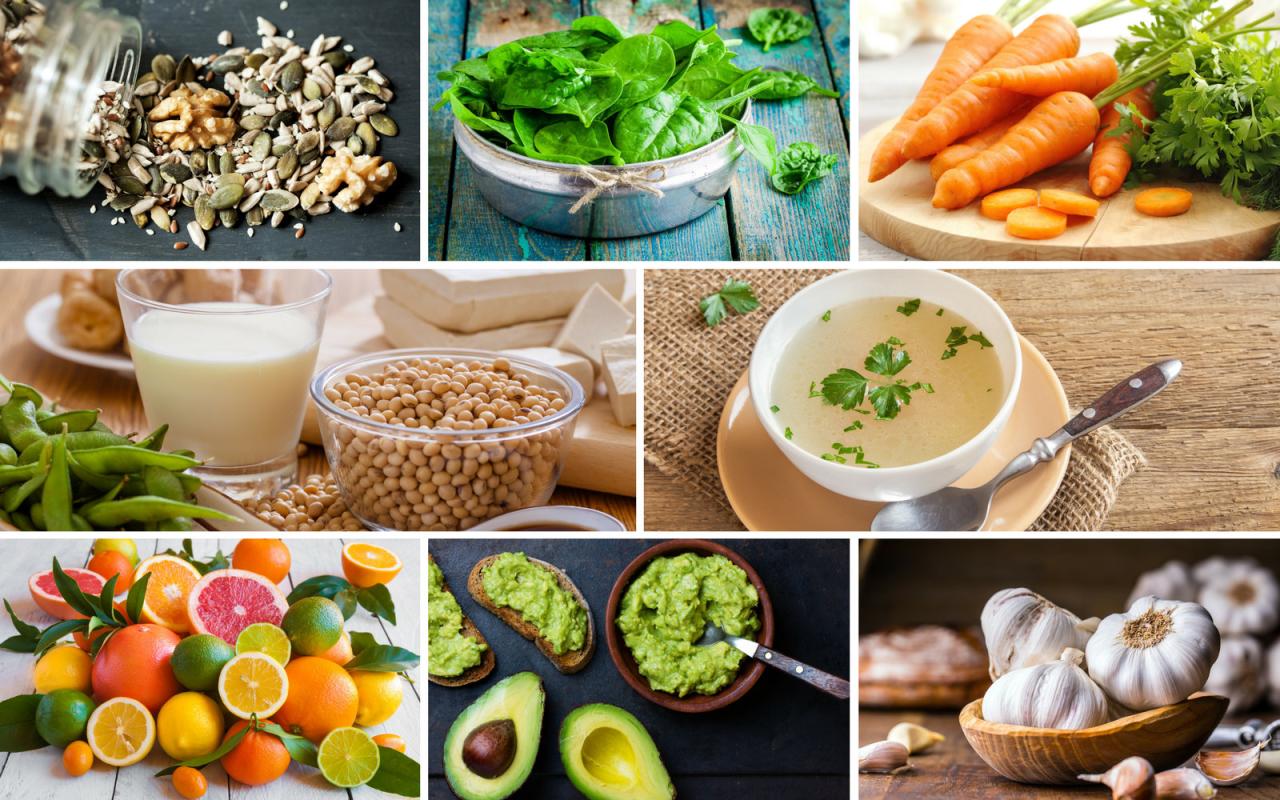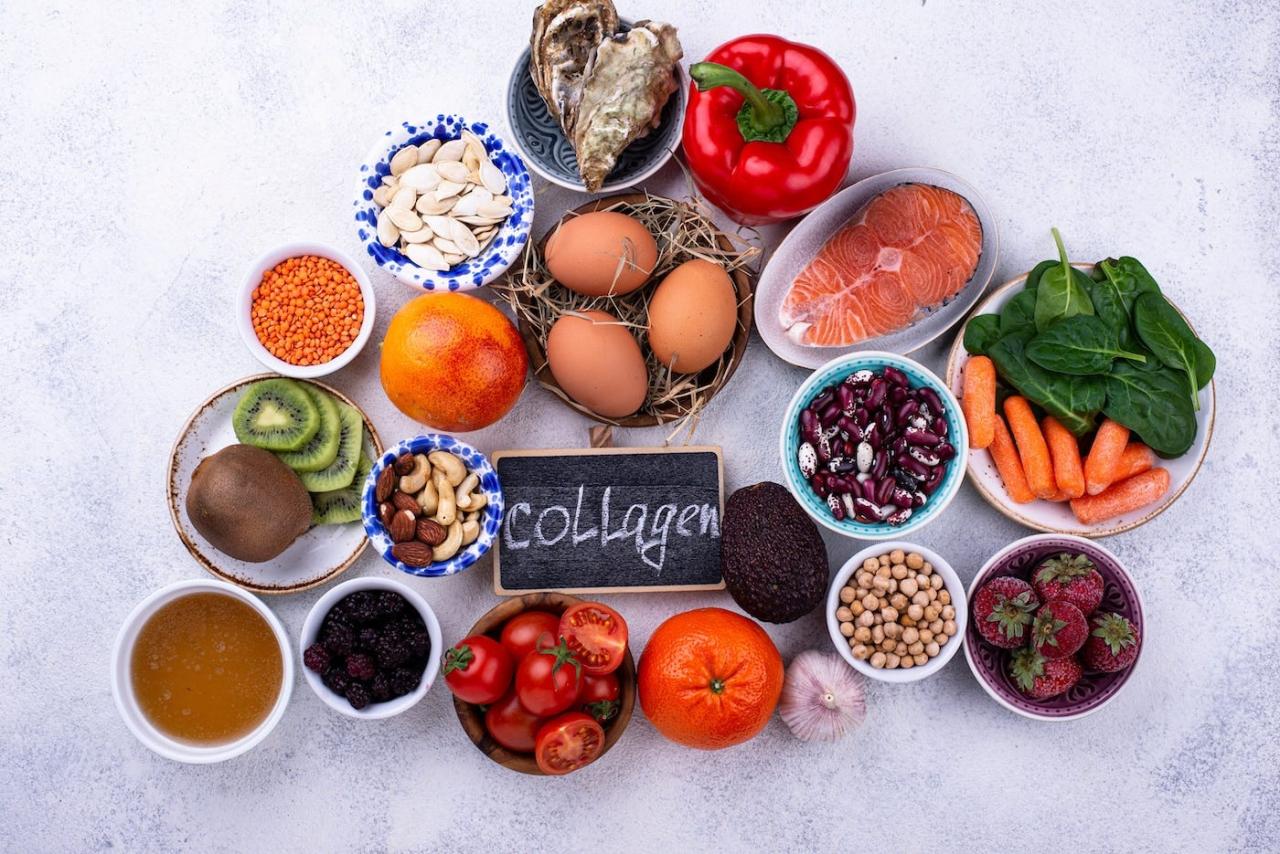Best collagen sources in food for natural intake? Forget those pricey powders! Your kitchen is brimming with collagen-boosting goodies, waiting to plump your skin and strengthen your bones. We’re diving deep into the delicious world of naturally collagen-rich foods, revealing the surprising places this beauty-building protein hides. Get ready to eat your way to a healthier, more radiant you – because who needs a lab when you have a lemon?
This journey will uncover the best sources of collagen in food, from succulent meats to surprisingly collagen-packed vegetables. We’ll explore how to maximize collagen absorption, debunk common myths, and even share some mouth-watering recipes to help you incorporate these collagen powerhouses into your daily diet. Prepare for a culinary adventure that’s as good for your insides as it is for your outsides!
Collagen: The Body’s Secret Weapon (and Where to Find It!): Best Collagen Sources In Food For Natural Intake
Collagen, that magical protein that keeps our skin supple, our joints lubricated, and our hair shiny, isn’t just some beauty buzzword. It’s a fundamental building block of our bodies, responsible for holding everything together. While our bodies naturally produce collagen, that production slows down as we age, leading to wrinkles, joint pain, and other age-related woes. Fortunately, we can boost our collagen intake through diet, and this article is your guide to the best sources of this wonder protein.
Introduction to Collagen and its Importance
Collagen is the most abundant protein in the human body, acting as the scaffolding for our skin, bones, tendons, ligaments, and cartilage. Think of it as the body’s internal glue, providing structure and support. Different types of collagen exist, each with specific roles. Type I is the most common, found in skin, bones, tendons, and ligaments; Type II is primarily in cartilage; and Type III supports the structure of organs and tissues.
Consuming collagen-rich foods can help replenish our stores, potentially mitigating the effects of aging and improving overall health.
The benefits of consuming collagen-rich foods are numerous, ranging from improved skin elasticity and reduced wrinkles to stronger joints and nails. Some studies even suggest potential benefits for gut health and wound healing. It’s like giving your body a natural, internal facelift – from the inside out!
Identifying Top Collagen Sources in Food
Many foods naturally contain collagen, although the amount and type vary. Let’s dive into the best sources, categorized for your convenience. Remember that bioavailability (how well your body absorbs the collagen) also plays a role.
| Food Group | Food | Approximate Collagen Content (per serving – this is a general estimate and can vary greatly) | Health Benefits |
|---|---|---|---|
| Meat | Bone Broth | Varies greatly depending on preparation; can be a significant source | Joint health, gut health, skin elasticity |
| Fish | Salmon Skin | Relatively high | Skin health, omega-3 fatty acids |
| Poultry | Chicken Skin | Moderate | Skin health, protein source |
| Vegetables | Leafy Greens (e.g., spinach, kale) | Low, but contains collagen-boosting nutrients | Overall health, vitamin and mineral intake |
| Meat | Beef | Moderate | Protein, iron |
| Fish | Cod | Moderate | Protein, omega-3 fatty acids |
| Poultry | Turkey | Moderate | Protein, lean protein source |
Bioavailability of collagen varies depending on the source and preparation method. Bone broth, for instance, is often cited for high bioavailability due to the gentle extraction process.
Collagen-Boosting Nutrients and Their Synergistic Effects
While consuming collagen-rich foods is key, certain nutrients act synergistically to enhance collagen production. These include Vitamin C (essential for collagen synthesis), zinc (important for wound healing and collagen formation), and copper (aids in collagen cross-linking).
Combining collagen-rich foods with these nutrients amplifies the benefits. For example, a hearty bone broth stew with plenty of bell peppers (rich in Vitamin C) and a sprinkle of sesame seeds (good source of zinc) provides a powerhouse of collagen-supporting ingredients.
Example Meal: A vibrant salad with grilled salmon (collagen and omega-3s), a generous helping of bell peppers (Vitamin C), and a sprinkle of pumpkin seeds (zinc and magnesium).
Preparation Methods to Maximize Collagen Intake, Best collagen sources in food for natural intake

Cooking methods significantly impact collagen extraction and bioavailability. Slow cooking, such as simmering bone broth for hours, allows for maximum collagen extraction. Conversely, high-heat methods can denature the collagen, reducing its effectiveness.
Tips for optimal collagen extraction include using low and slow cooking methods, avoiding high heat, and using pressure cookers (which achieve high temperatures but maintain pressure, leading to better collagen extraction).
Recipe: Slow-Cooker Chicken Bone Broth: Place chicken bones, carrots, celery, onion, and water in a slow cooker. Cook on low for 12-24 hours. Strain and enjoy! The long, slow cooking process extracts maximum collagen from the bones.
Comparing Collagen Sources: Quantity vs. Quality

Different collagen sources offer varying amounts of collagen and other beneficial nutrients. The choice depends on individual needs and preferences.
- Bone Broth: High collagen content, good bioavailability, rich in minerals.
- Salmon Skin: Moderate collagen, rich in omega-3 fatty acids, good for skin health.
- Chicken Skin: Moderate collagen, easily accessible, but higher in fat.
Assessing nutritional value goes beyond simply looking at collagen content. Consider the overall nutrient profile, including vitamins, minerals, and other beneficial compounds.
Factors Affecting Collagen Absorption and Utilization
Several factors influence the body’s ability to absorb and utilize collagen. Age plays a significant role, as collagen production naturally declines with age. Gut health is crucial; a healthy gut allows for better nutrient absorption, including collagen. Overall diet also matters; a balanced diet supports optimal collagen production and absorption.
A healthy gut is paramount for collagen absorption. Consume plenty of fiber-rich foods, probiotics, and prebiotics to support a thriving gut microbiome.
Recommendations for optimizing gut health include consuming fermented foods (like yogurt and kimchi), increasing fiber intake, and minimizing processed foods and sugar.
Visual Representation of Collagen-Rich Foods
Let’s paint a picture of three collagen-rich foods:
1. Bone Broth: Imagine a rich, amber liquid, slightly cloudy with flecks of tiny vegetables. The aroma is savory and comforting, with hints of onion, garlic, and herbs. After simmering for hours, the broth has deepened in color and richness, reflecting the collagen extracted from the bones.
2. Salmon Skin: Picture a glistening, reddish-orange skin, slightly crispy and translucent in areas. The texture is firm yet delicate, with a slightly chewy quality. When pan-seared, the skin becomes deeply golden-brown, with a crisp and slightly charred exterior.
3. Chicken Skin: Envision a thin, slightly translucent layer of skin, pale yellow or light golden in color. The texture is smooth and soft, becoming crispy and golden-brown when roasted or pan-fried. The cooked skin has a satisfying crunch and a savory, slightly fatty flavor.
Epilogue
So, ditch the collagen supplements and embrace the deliciousness of nature’s collagen bounty! From savory bone broths to vibrant veggies, your journey to radiant skin and stronger joints starts with the food on your plate. Remember, it’s not just
-what* you eat, but
-how* you prepare it that unlocks the full collagen potential. Happy cooking (and glowing!), friends!
